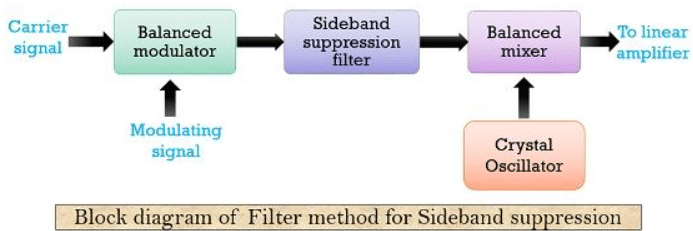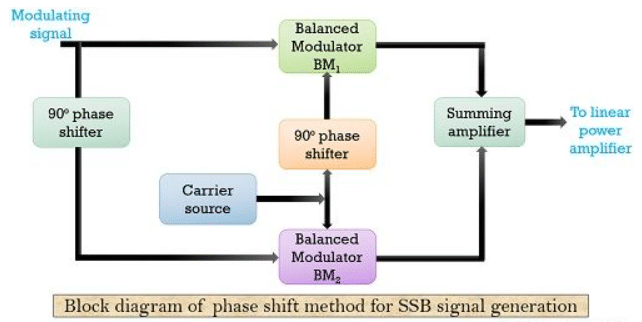Single Sideband (SSB) Modulation | Communication System - Electronics and Communication Engineering (ECE) PDF Download
Definition
Single sideband modulation (SSB) is an amplitude modulation scheme in which only a single sideband is transmitted through the channel. It is also known as SSB-SC which is an acronym for Single Sideband Suppressed Carrier as it allows suppression of one sideband and carrier completely.
As we know, DSB-SC modulation technique generates an output wave having twice the bandwidth as that of the original modulating signal. So, in order to avoid doubling factor of bandwidth in such modulation system, the SSB-SC modulation technique was introduced.
Why is the suppression of a sideband allowed in SSB modulation?
Single sideband modulation technique was adopted, as by suppression of one of the two sidebands along with the carrier causes no loss of information.
This is so because the two sidebands of the modulated signal are particularly related to each other. In other words, we can say the two sidebands carry similar information. Thus, for the transmission of information, we need only one sideband. So, by suppressing one sideband along with the carrier, no any information is lost.
Hence, the bandwidth requirement also gets reduced to half and there are chances for an accommodation of twice number of channels using the SSB modulation technique.
Mathematical Expression
Let the modulating signal be,
m(t) = Am cos (2πfmt)
and carrier signal
c(t) = Ac cos (2πfct)
As we have discussed the similar expression in DSB-SC modulation. So, here we can write,
It is a combination of 2 sidebands,
However, we know that the DSB-SC amplitude modulated wave requires a bandwidth of 2fm. But, due to the presence of single sideband in SSB modulation, the bandwidth requirement is reduced to half. Hence, bandwidth in case of SSB-SC amplitude modulation wave is fm.
Methods of generation of Single Sideband modulated wave
- Frequency discrimination method (Filter method)
- Phase shift method
Frequency discrimination method
First, have a look at the block diagram of Filter method for suppression of one sideband.
- The balanced modulator employed here generates DSB-SC amplitude modulated wave as its output.
- As the DSB output contains the two sidebands, and only carrier component is suppressed, so sideband suppression filter is needed further in order to eliminate one of the 2 sidebands.
- The filter characteristics should be such that, it must have flat passband and should possess high attenuation beyond the passband. So, to have such a response, the tuned circuit must have a very high Q factor.
- To have such a high Q factor it is needed that the difference between modulating frequency and carrier frequency to be high. There is no any practical way to achieve such a high value.
- Thus, modulation at the initial stage is carried out at a low frequency of about 100 KHz by the balanced modulator. After this one sideband is suppressed by the filter. But, as the SSB signal frequency is very low in comparison to transmitter frequency. So, a balanced mixer and crystal oscillator are employed in the circuit to boost the frequency of SSB signal up to the level of transmitter frequency.
- Then the SSB signal is fed to a linear amplifier for further amplification. The process of frequency boosting is sometimes also termed as Up-conversion.
- Basically to eliminate unwanted sideband- LC, ceramic, crystal or mechanical filter are used. Though ceramic or crystal filters are low in cost but provides better results at operating frequency above 1 MHz. Among all these mechanical filters possess the best characteristics thus is widely used.
Advantages of Filter method
- It provides sufficiently flat and wide bandwidth.
- By this method, we can have suitable sideband suppression.
Disadvantages of Filter method
- Frequency up-conversion at the end is necessary as the system does not generate SSB at high frequencies.
- Expensive filter increases the overall cost of the system.
Phase shift method
The figure below shows the block diagram of the phase shift method used for the generation of the SSB signal.
- The carrier signal generated by the carrier source is fed to the balanced modulator 1 or BM1 after it is phase shifted by 90⁰. Also, the modulating or baseband signal is applied to the BM1.
- Moreover, the carrier is directly fed to the Balanced modulator 2 or BM2, along with this a 90⁰ phase shifted modulating signal is also applied to the same. Thus, at the output of the two balanced modulators, signals consisting of 2 sidebands are achieved. BM1 generates USB and LSB but both with a phase shift of +90⁰.
- Similarly, BM2 also generates a signal with both sidebands, but USB is shifted by +90⁰ while LSB is shifted by -90⁰.
- Further, the summing amplifier adds the output of the two balanced modulators. As the two balanced modulator shifts the USB by +90⁰ each, this generates a double amplitude signal. However, the 2 balanced modulator shifts the LSB by +90⁰ and -90⁰, thus cancels each other.
- Hence at the output of summing amplifier, we only have USB of SSB signal.
Advantages of Phase shift method
- It does not require a frequency up-conversion stage.
- The modulating signal can be a low-frequency audio signal.
- Switching between the sidebands is easier.
Disadvantages of Phase shift method
- The designing of phase shifting circuitry is complex.
- It requires phase shifting to be accurate, which is a difficult task.
Advantages of SSB modulation
- It allows multiple signals to transmit.
- SSB technique requires less bandwidth as compared to DSB technique.
- Less power is consumed.
- It allows transmission of the high power signal.
- It provides less interference to noise due to the reduction in bandwidth.
Disadvantages of SSB modulation
- Implementation of SSB holds complex nature.
- It is expensive.
- SSB technique requires a transmitter and receiver to be highly frequency stable. As some slight change in frequency will deteriorate the quality of the signal.
Applications of SSB modulation
- It is needed in all such applications where power saving and low bandwidth is required.
- The technique is utilized in point to point communication.
- It is also used in land and air mobile communication.
- It also finds its applications in telemetry and radar communication.
Quartz crystals are mostly used in the manufacturing of filters that are employed in the SSB modulation system.
|
13 videos|39 docs|30 tests
|





















